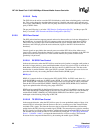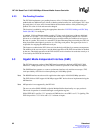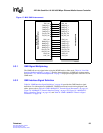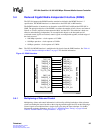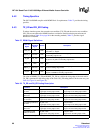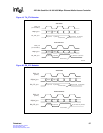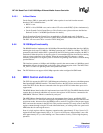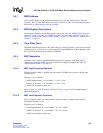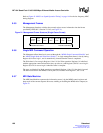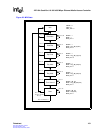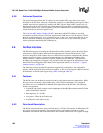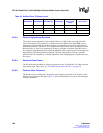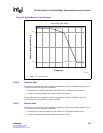
IXF1104 Quad-Port 10/100/1000 Mbps Ethernet Media Access Controller
98 Datasheet
Document Number: 278757
Revision Number: 007
Revision Date: March 25, 2004
5.4.3.1 In-Band Status
Carrier Sense (CRS) is generated by the PHY when a packet is received from the network
interface. CRS is indicated when:
• RXDV = true.
• RXDV = false, RXERR = true, and a value of FF exists on the RXD[7:0] bits simultaneously.
• Carrier Extend, Carrier Extend Error, or False Carrier occurs (please reference the Hewlett-
Packard* Version 1.2a RGMII Specification for details.).
Carrier Extend and Carrier Extend Error are applicable to Gigabit speeds only. Collision is
determined at the MAC by the assertion of TXEN being true while either CRS or RXDV are true.
The PHY will not assert CRS as a result of TXEN being true.
5.4.4 10/100 Mbps Functionality
The RGMII interface implements the 10/100 Mbps Ethernet Media Independent Interface (MII) by
reducing the clock rate to 25 MHz for 100 Mbps operation and 2.5 MHz for 10 Mbps. The TXC is
generated by the MAC and the RXC is generated by the PHY. During packet reception, the RXC is
stretched on either the positive or negative pulse to accommodate transition from the free-running
clock to a data-synchronous clock domain. When the speed of the PHY changes, a similar
stretching of the positive or negative pulses is allowed. No glitching of the clocks is allowed during
speed transitions.
This interface operates at 10 Mbps and 100 Mbps speeds in the same manner as 1000 Mbps speed,
although the data may be duplicated on the falling edge of the appropriate clock. The MAC holds
TX_CTL Low until it is operating at the same speed as the PHY.
Note: The IXF1104 does not support 10/100 Mbps operation when configured in GMII mode
5.5 MDIO Control and Interface
The IXF1104 supports the IEEE 802.3 MII Management Interface, also known as the Management
Data Input/Output (MDIO) Interface. This interface allows the IXF1104 to monitor and control
each of the PHY devices that are connected to the four ports of IXF1104 when those ports are in
copper mode.
The MDIO Master Interface block is implemented once in the IXF1104. The MDIO Interface block
contains the logic through which the user accesses the registers in PHY devices connected to the
MDIO/MDC interface, which is controlled by each port.
The MDIO Master Interface block supports the management frame format, specified by IEEE
802.3, clause 22.2.4.5. This block also supports single MDI access through the CPU interface and
an autoscan mode. Autoscan allows the MDIO master to read all 32 registers of the per-port copper
PHYs and store the contents in the IXF1104. This provides external-CPU-ready access to the PHY
register contents through a single CPU read without the latency of waiting on the low-speed serial
MDIO data bus for each register access.
Scan of a single register with low-frequency operation takes approximately 25.6 µs. Scan of a 32-
register block takes approximately 820 µs, or 3.3 ms for all four ports. Autoscan data is not valid
until approximately 19.2 µs after enabling scan. These numbers scale by 7/50 for high-frequency
operation.



